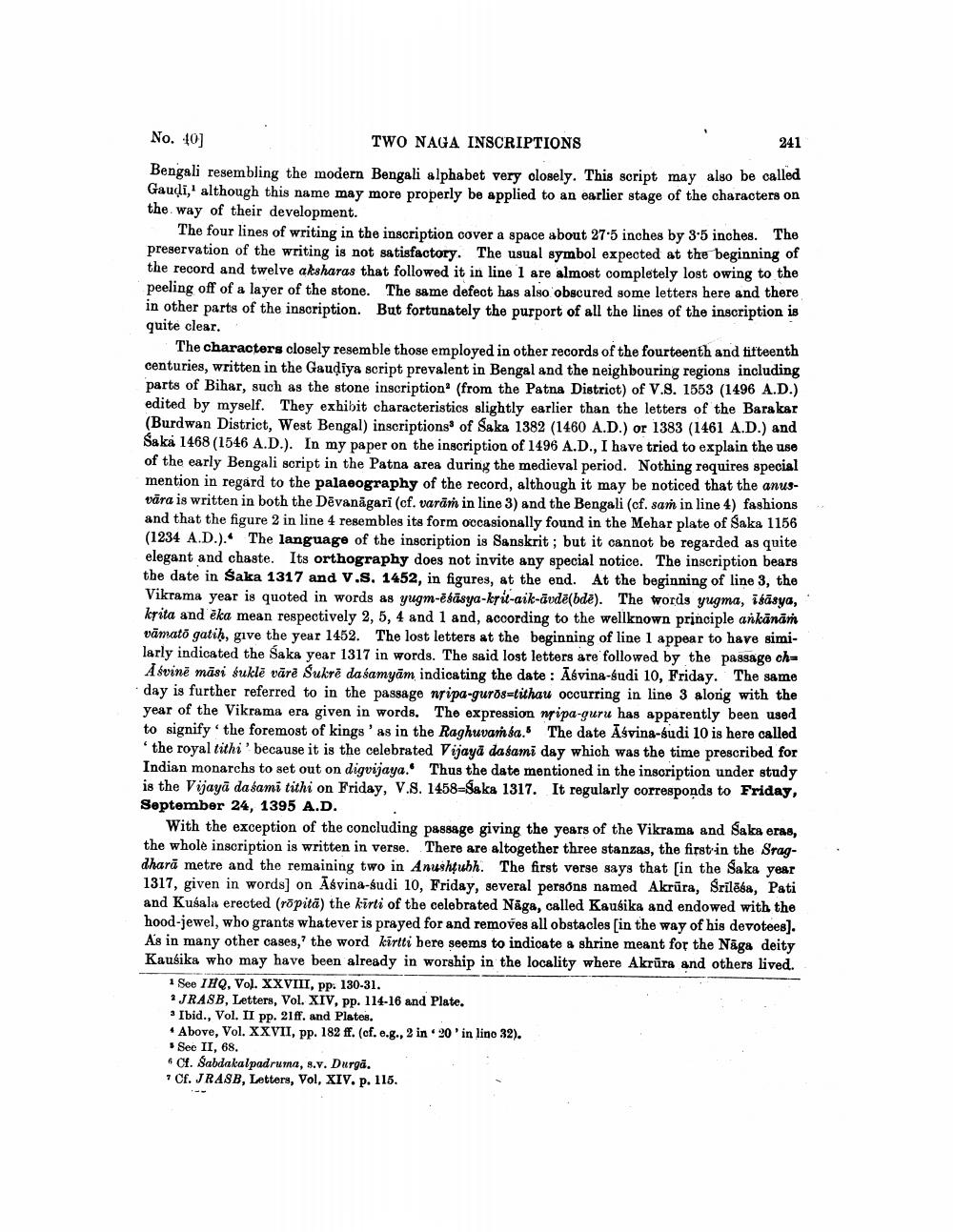________________
241
No. 400
TWO NAGA INSCRIPTIONS Bengali resembling the modern Bengali alphabet very closely. This script may also be called Gaudi, although this name may more properly be applied to an earlier stage of the characters on the way of their development.
The four lines of writing in the inscription cover a space about 27.5 inches by 3.5 inches. The preservation of the writing is not satisfactory. The usual symbol expected at the beginning of the record and twelve aksharas that followed it in line 1 are almost completely lost owing to the peeling off of a layer of the stone. The same defect has also obscured some letters here and there in other parts of the inscription. But fortunately the purport of all the lines of the inscription is quite clear.
The characters closely resemble those employed in other records of the fourteenth and fifteenth centuries, written in the Gaudiya script prevalent in Bengal and the neighbouring regions including parts of Bihar, such as the stone inscription' (from the Patna District) of V.8. 1553 (1496 A.D.) edited by myself. They exhibit characteristics slightly earlier than the letters of the Barakar (Burdwan District, West Bengal) inscriptions of Saka 1382 (1460 A.D.) or 1383 (1461 A.D.) and Saká 1468 (1546 A.D.). In my paper on the inscription of 1496 A.D., I have tried to explain the use of the early Bengali script in the Patna area during the medieval period. Nothing requires special mention in regard to the palaeography of the record, although it may be noticed that the anusvāra is written in both the Dēvanagari (cf. varāṁ in line 3) and the Bengali (cf. sam in line 4) fashions and that the figure 2 in line 4 resembles its form occasionally found in the Mehar plate of Saka 1156 (1234 A.D.). The language of the inscription is Sanskrit ; but it cannot be regarded as quite elegant and chaste. Its orthography does not invite any special notice. The inscription bears the date in Saka 1317 and V.s. 1452, in figures, at the end. At the beginning of line 3, the Vikrama year is quoted in words as yugm-esāsya-krit-aik-āvda(bde). The words yugma, isāsya, krita and ēka mean respectively 2, 5, 4 and 1 and, according to the wellknown principle ankānām vämato gatih, give the year 1452. The lost letters at the beginning of line 1 appear to have similarly indicated the Saka year 1317 in words. The said lost letters are followed by the passage ch= A svinē māsi buklë vāre Sukrē da samyām indicating the date : Asvina-sudi 10, Friday. The same day is further referred to in the passage nipa-gurds=lithau occurring in line 3 alorig with the year of the Vikrama era given in words. The expression npipa-guru has apparently been used to signify the foremost of kings 'as in the Raghuvarsa. The date Āývina-sudi 10 is here called
the royal tithi' because it is the celebrated Vijaya da sami day which was the time prescribed for Indian monarchs to set out on digvijaya. Thus the date mentioned in the inscription under study is the Vijaya da sami tithi on Friday, V.S. 1458-Saka 1317. It regularly corresponds to Friday, September 24, 1395 A.D.
With the exception of the concluding passage giving the years of the Vikrama and Saka eras, the whole inscription is written in verse. There are altogether three stanzas, the first in the Sragdhară metre and the remaining two in Anushubh. The first verse says that [in the Saka year 1317, given in words) on Āsvina-sudi 10, Friday, several persons named Akrūra, Srilēsa, Pati and Kusala erected (rõpitā) the kirti of the celebrated Näga, called Kausika and endowed with the hood-jewel, who grants whatever is prayed for and removes all obstacles (in the way of his devotees). As in many other cases, the word kirtti bere seems to indicate a shrine meant for the Näga deity Kausika who may have been already in worship in the locality where Akrüra and others lived.
1 See IHO, Vol. XXVIII, pp. 130-31. 2 JRASB, Letters, Vol. XIV, pp. 114-16 and Plate. * Ibid., Vol. II pp. 21ff. and Plates. . Above, Vol. XXVII, pp. 182 ff. (cf. e.g., 2 in 20'in lino 32).
See II, 68. 6 Cf. Sabdakalpadruma, s.v. Durgā. * Cf. JRASB, Letters, Vol. XIV. p. 115.




